Castillo de Gibralfaro
last update: 31 January 2021

This webpage is dedicated to the Castillo de Gibralfaro and not to the Alcazaba de Málaga, which in itself is worth a separate visit. Above we can see the castillo in all its glory, and next to it the Parador of Málaga.
Introduction
The castle (castillo) is said to have its origins as an ancient Phoenician (1500-539 BC) enclosure containing a lighthouse that gave its name to the hill Gibralfaro (Jbel-Faro or lighthouse hill). This is just one version, because the English Wikipedia tells us that Jbel-Faro is Phoenician for light, meaning "rock of light". However, in a local guide book they mention that Yabel is an Arabic word for mountain, and Faruk a Greek word for lighthouse.
We are told that Abd-al-Rahman III (889-961), Emir and Caliph of Córdoba, transformed the ancient fortress ruins that were said to have existed even before the arrival of the Romans. In 1340 the fort was expanded and turned into a fortress (i.e. an alcázar) by the Nasrid Sultan Yusuf I. In 1487 the castle finally fell to the Reyes Católicos, and Fernando II took it as residence while Isabel I de Castilla chose to live in the city.
The castle sits on a foothill of the Montes de Málaga mountain range, which is located to the east and north of the city.
Today the castle can be visited, and from its keep there are magnificent views over the city of Málaga. On a clear day they say it is possible to see the Rif Mountains (in northern Morocco) and the Strait of Gibraltar, but I’m not convinced given the mist and pollution that appears to permanently hang over the city for long periods of the year.

What can we see today?
The problem when visiting something like an old fortress is the different between what we can see now, and what was there is the past. Always assuming there was just one 'past' and the place had not been highjacked by different civilisations and cultures, e.g. converting an ancient storeroom into public toilets, etc. So our task is to look at what we can see today, and try to imagine what it might have been in some distant past. So lets start with the guided tour…
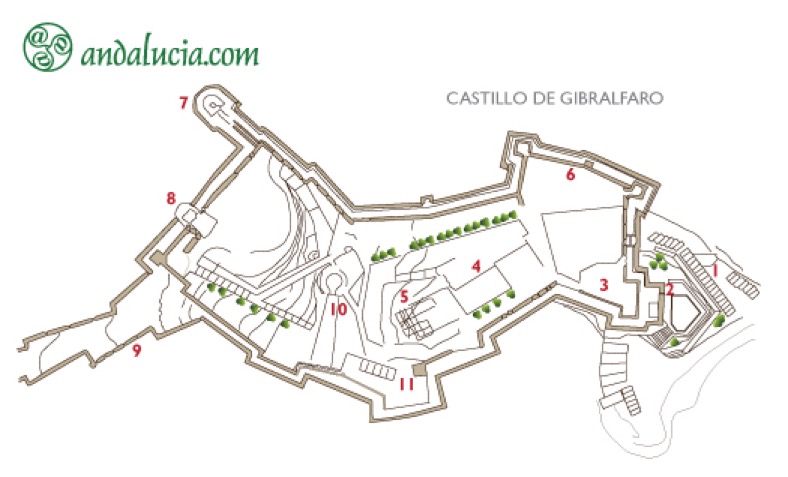
1. Car Park
2. Entrance
3. Lookout Tower - Torre Mirador
4. “Interpretation” Centre
5. Bar and toilets
6. Airón Well - Pozo Airón
7. White Tower - Torre Blanca
8. Original Gateway
9. Coracha
10. Octagonal Cistern Well - Aljibe Octogonal
11. Baker’s Oven - Hornos de pan
The first thing is to dispel the confusion between Alcazaba and alcázar. Alcazaba is a Moorish fortification, and is a walled-fortification inside a city. Alcázar is a type of Moorish castle, and after the expulsion of the Moors from Spain the same word was often used to refer to palaces as well. Below we have an idea of the Moorish Málaga in 1487 when the Christians starved the city into submission.
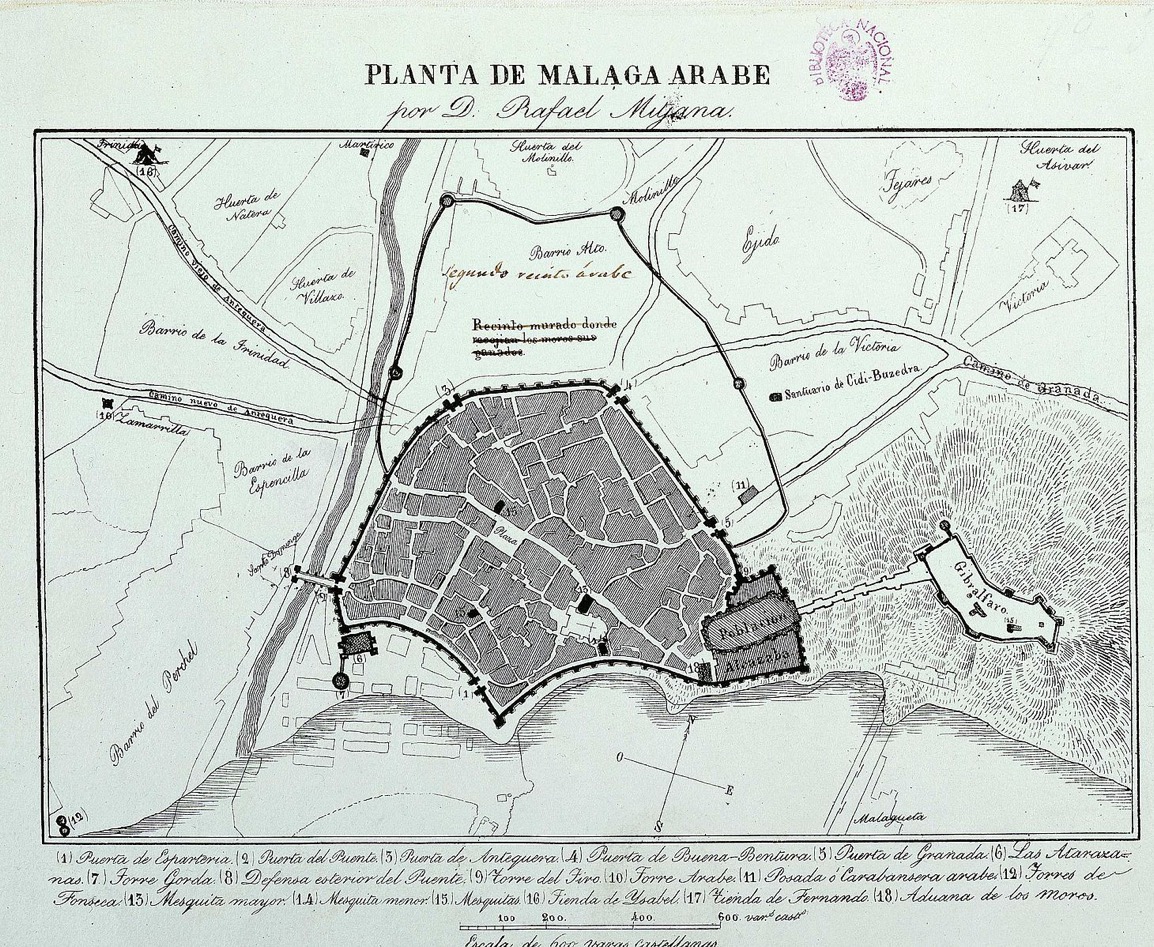
It is said that the city from Roman times had a defensive wall, which was then added to by the Phoenician and then by the Arabs. In ca. 1487 the city had a defensive wall with five gates (as seen above) and a whole series of defensive towers. There were both 'puertas' or gates, and some much smaller 'postigos' or entrances with a single door. These walls, gates and doorways no longer exist. The Puerta de Espartería (today Calle Sancha de Lara), nearby there was also a Puerta del Mar which really acted as the main link between the harbour and the Plaza Mayor (see Calle Puerta del Mar). This is where ships docked and so it saw a lot of movement of merchandise and soldiers.
Puerta de Granada was retained after the conquest, and a new gate was also opened called Puerta Nueva. One problem was that little by little people would attach houses to the interior of the wall along the Guadalmedina, and throw their 'rubbish' over the wall, making the river-moat and dunghill. In an attempt to move people away from the wall they proposed free land in the area between Puerta de Granada and Puerta Nueva.
There was also a so-called Puerta Oscura, which accessed the Alcazaba. It was called 'oscura' (dark) simply because a nearby tower put the doorway in a gloom shade. There was also a Puerta de la Caba which linked the Medina with the Alcazaba.
The Puerta Las Atarazanas was where the river entered the sea. The Mezquita de Atarazanas was there, and in Arab times there was a tower from which they would call the faithful to prayer. After the conquests this gate was maintained, but the tower was demolished and replaced with what people called Torre Gorda (the 'fat tower').
If we look to the right of Puerta de Espartería we can see the wall pointing out to sea. On that corner was the Castillo de los Genoveses, which had served as a kind of factory for the merchants of the Italian Republic from Nasrid times. There was an addition gate that served as an entrance to the Castillo de los Genoveses, called Puerta de la Cava or Puerta de los Siete Arcos, depending on the source. The whole area was demolished in 1785. There is always potential for confusion, and I'm not certain that Puerta de la Caba and Puerta de la Cava are not the same, and one text mentioned that the Puerta de los Siete Arcos provided access behind the Castillo de los Genoveses and not to it.
We can also see the Alcazaba, and the fortified “coracha” leading up to the alcázar or Castillo Gibralfaro.
Below we can see the model in the “Interpretation” Centre in the castillo. The picture is not that good but we can see the castillo (or alcázar) connected to the Alcazaba by the fortified “coracha”.
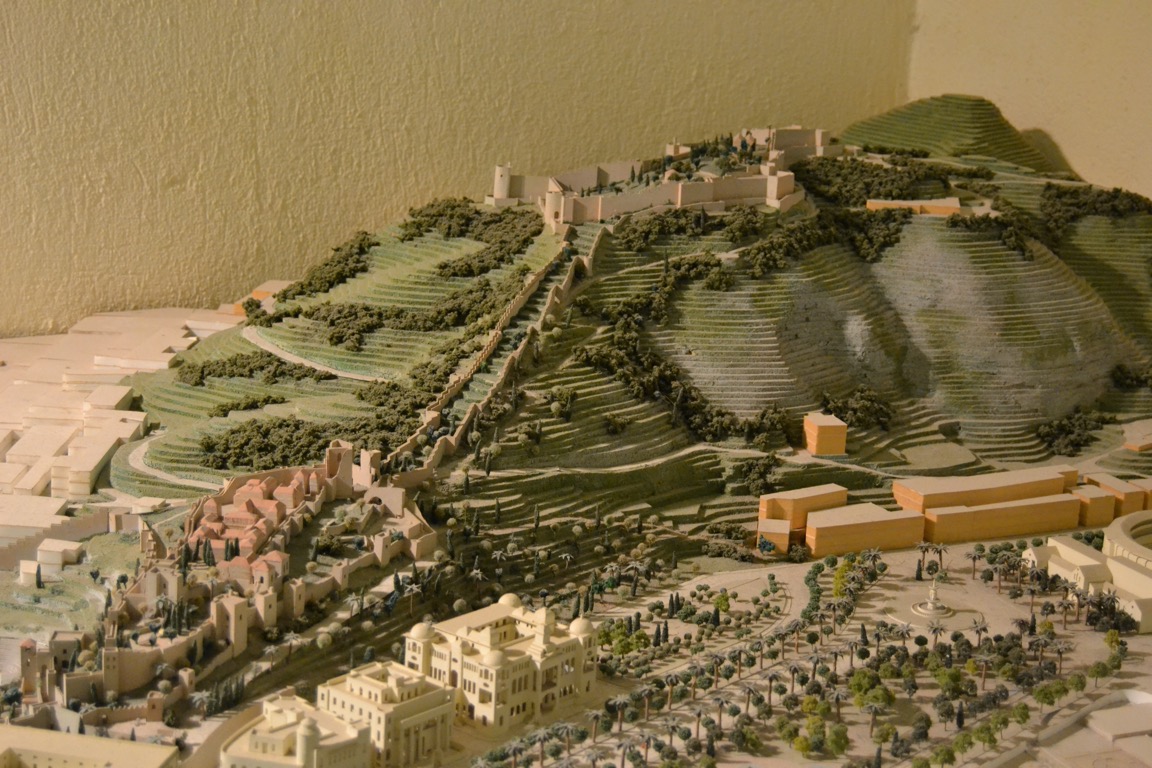
So back to the castillo. Guide books tell us that it was built in the 14th C to house troops and protect the Alcazaba. Artillery had become common place, and the city could easily be put under sieges by occupying the hills around it. The “new” castillo was state-of-the-art at the time. The rampart walls adapted to the terrain created zigzag walls and an angled gateway. Flanking towers were introduced. Walls were topped with embrasures, e.g. the battlements consisted of walls topped with a parapet and crenels (or merlons).
Today the entrance is up near the lookout tower. Below we can see the lookout tower overlooking the entrance car-park. This lookout tower is, not surprisingly, the highest point in the castillo. It was called the bastión este, and was home to the "batería del Viento". I'm not sure, but I think that this tower was also known as the "Torre Mirador" (watchtower), sometimes also called the "torre mayor". It was autonomous in that it had its own water supply, barracks and warehouses. In someways this building was more a bastión than just a tower, since it was both watchtower and a gun placement for defending the outer walls.
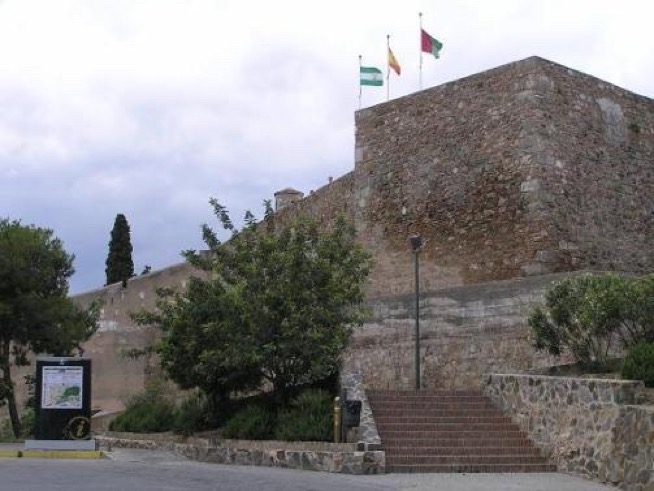
Once you have your ticket, you walk along part of a fortified passageway ("pasillo fortificado") at the base of the fortress walls to the gated entrance.
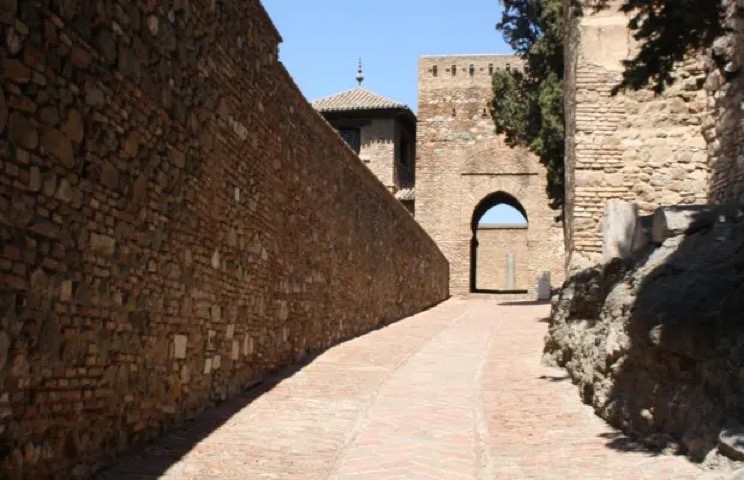
On entering the castillo you really have two options, either tour the grounds, or climb on to the walls. By far the most interesting option is to walk the ramparts. Below we are on what is called a 'adarve', from the Arab 'ad-darb' for a narrow walkway or path above a wall, usually protected by a 'almena' or crenellated parapet. This is the route that sentries would take as they made their rounds, and you can just see a small round guard post in the distance. The white building on the right was the "Almacenes de Artillería", the munitions store.
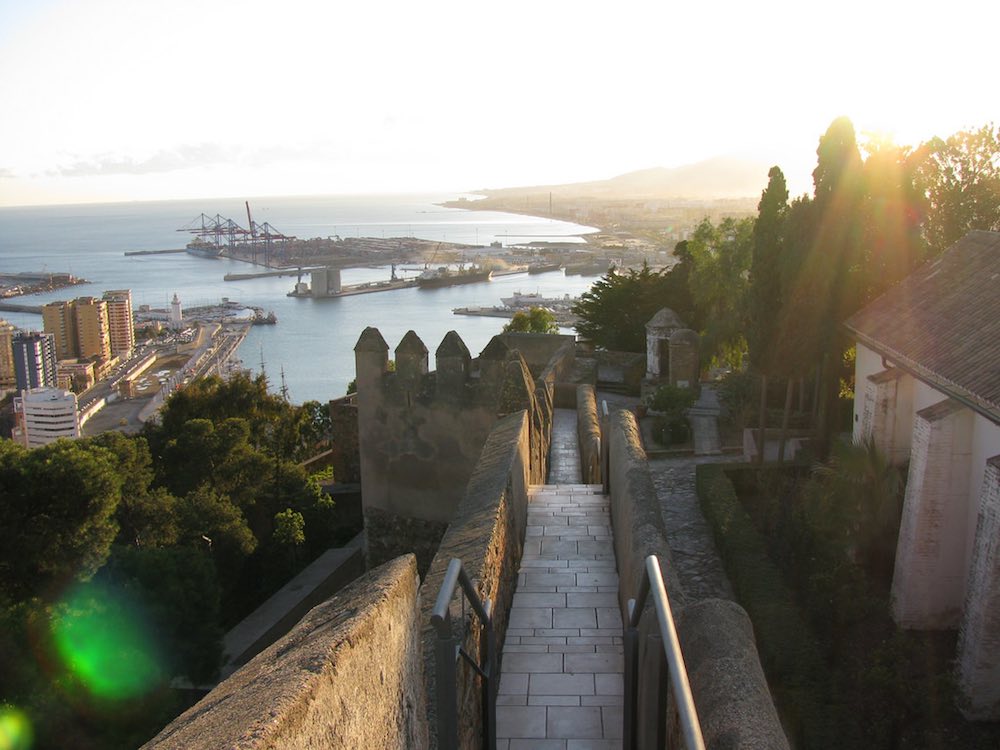

Above I think we are on the southern wall, just past was is called the 'batería de la Reina', and going down to the famous 'coracha' that linked the Castillo with the Alcazaba.
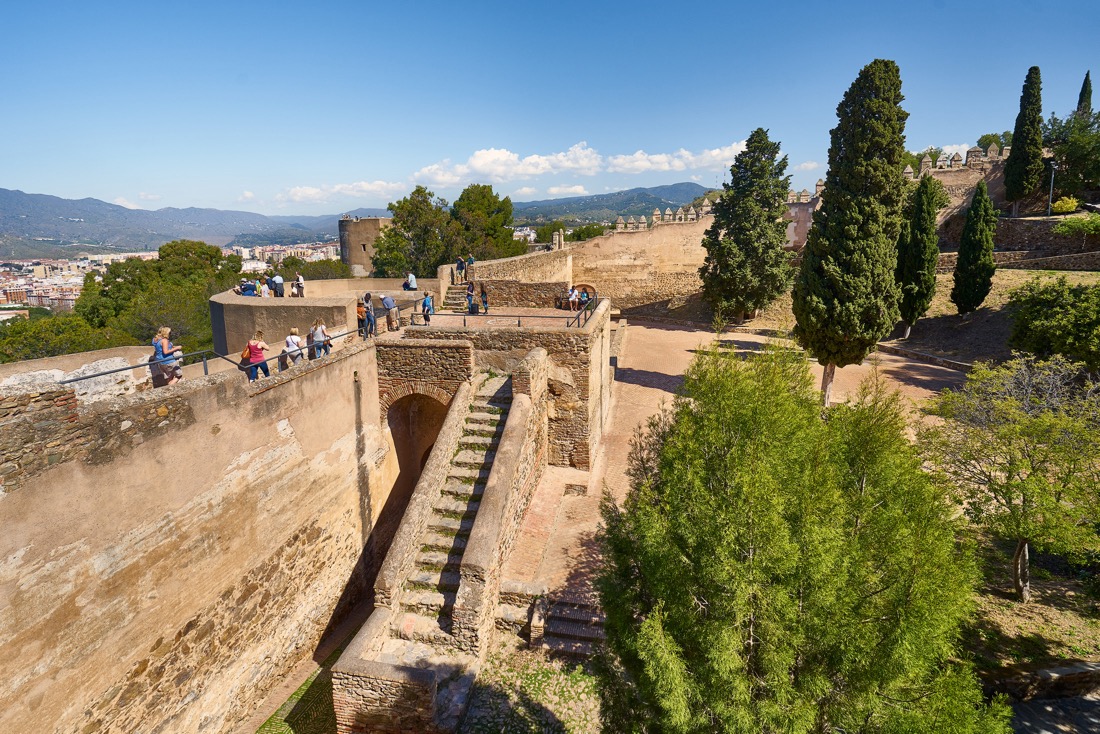
Above we have a view of the west defensive wall. In front of us we have the stairs leading to the roof of what is simply described as a blockhouse ("cuadras"), but you can see that it sits next to the west gate ("puerta oeste"). Hidden from view behind the blockhouse there were the infantry barracks ("Cuartel de Infantería"). And in the distance you can just see the so-called "Batería de la Sangre" jutting out on the left. Have look at the below photograph of the west gate dated to ca. 1920. You can appreciate the enormous effort made in restoring the castillo.
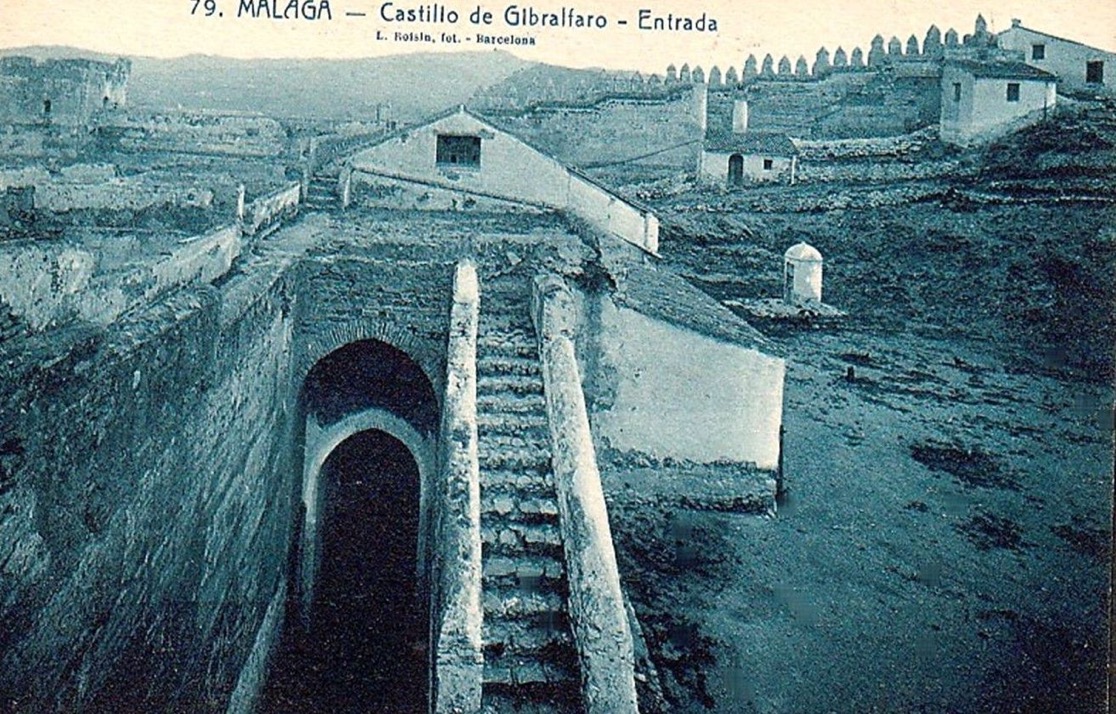
Below we have lower part of the north wall against which would have been installed the kitchens, of course separated for officers and soldiers.
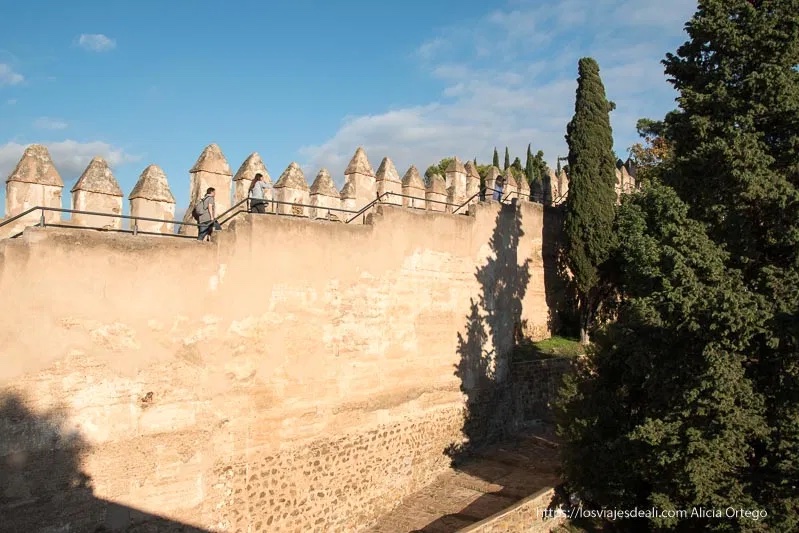
The castillo had two towers of note, one was the "Torre Mirador" at the entrance to the site. The other was the Torre Blanca (white tower), attached to the wall by a narrow walkway (see below). It housed a cistern for rainwater collection and storage rooms for ammunition and supplies. I have also seen this tower called Torre Albarrana, which I understand to have meant an “outside” watchtower connected to a fortified wall by a bridge or arch which could easily have been destroyed if the tower were captured. I also read that the lower parts of this tower were used as a prison.
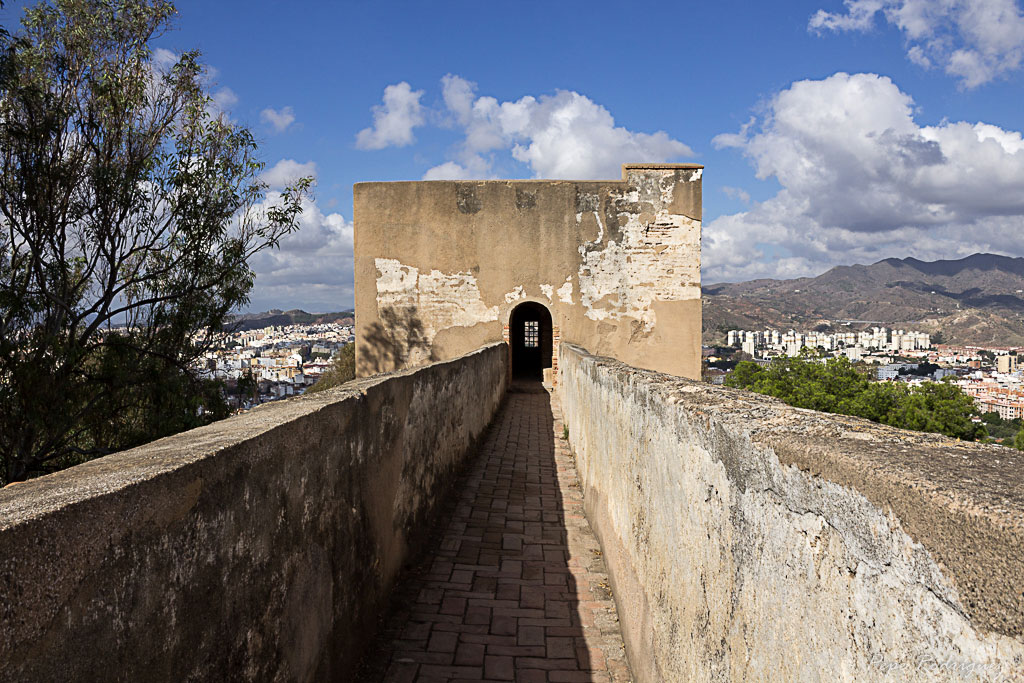
This may not appear much to look at, but below we have a photograph taken in ca. 1920. Again, this is just to highlight the restoration effort made by the local authorities.
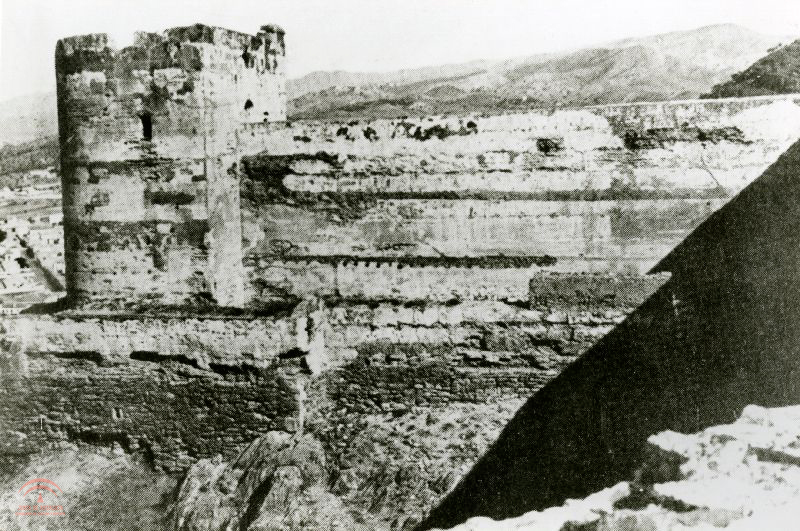
In many ways the castillo was totally autonomous from the city below. It had three wells ("aljibe"), kitchens, bread ovens ("hornos"), a horse corral, dungeons ("calabozo"), and even a secret escape route ("escusado").
We now turn to perhaps the most interesting part of the castillo, the fortified “coracha” leading down to the Alcazaba. The first thing to avoid is the confusion between the fortified “coracha” and La Coracha, which was an old neighbourhood situated on the side of the Alcazaba. The problem is accentuated because there are pictures of a long sloping street with old houses on one side that could be confused for the “coracha” route leading down to the Alcazaba. Below we have a view of the castillo and the Alcazaba, and we can just about see the fortified “coracha” linking the two.

The next thing we need to clarify is that a “coracha” (see below left) was usually a protective wall between a fortification and an access to water outside the fortified compound. Whereas our fortified path (see below right) was used to connect the castillo to the Alcazaba and had a completely different function and scale. It would have been used in the defence of the Alcazaba and the city in general. It could also have acted as a last refuge for those in the Alcazaba.
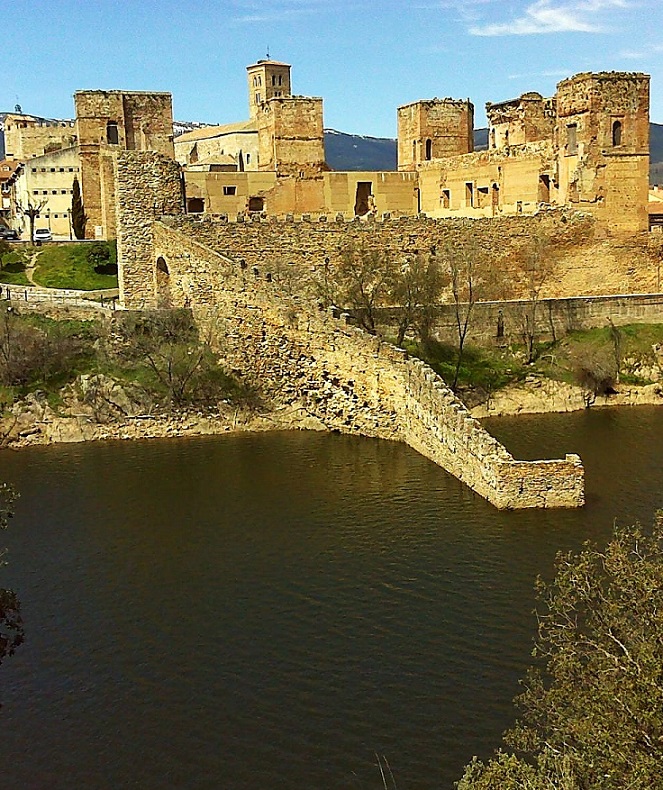
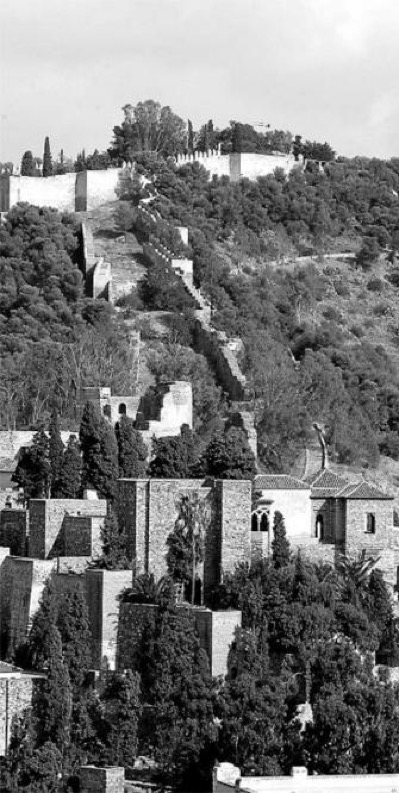
Below we can see an old postcard showing the castillo, and the fortified “coracha” leading down to the Alcazaba. Pottery shards have been found dating back to the Punic period (say from the 5th C BC), and there are some remains suggesting that the site was also a Roman lighthouse. The evidence concerning an early fortress built on the hill is very limited, and there is much confusion with other fortresses said to have been built in the region. It has been suggested that the site was home to an early mosque ("mezquita") and possibly even a cemetery, dating back to the 10th C AD. Other experts have suggested that we must wait to the 12th C to see the site being used as a cemetery, and have a possible religious-military significance.
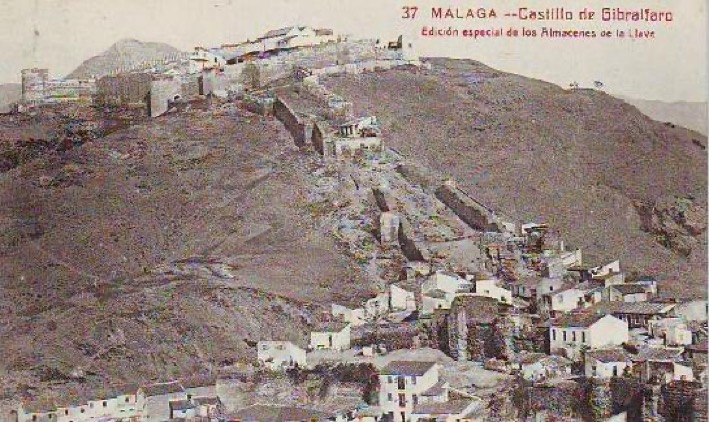
It has also been suggested that the castillo was constructed in two phases, defined by two patio areas. The upper Patio Principal, defined by the "Torre Mirador" and the *Pozo Airón" (a well), included a mosque (long disappeared), a deep well of the Phoenician period, and baths. The lower patio, in Christian times called "Plaza de Armas", was divided into two terraces and housed the stables and the troops.
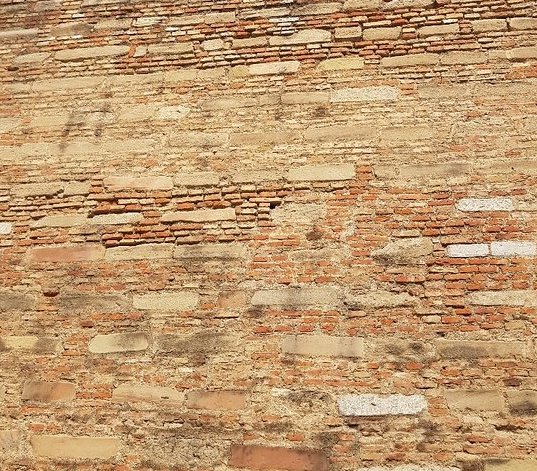
Although heavily restored it is still possible to see something of the original Nasrid construction work. Generally the technique of the day was called "tapial". In this particular case the lower courses were made with a small reddish brick bonded with a mortar made of soil/sand and lime granules. The upper courses were made with small pieces of slate. The lower part would have been surfaced with the same bonding mix. The surface would have been smooth. A plank moulding would have been used to tampered the mix to the wall, and the planks would probably have left marks on the surface. This type of surfacing would have been different from the gypsum mortar used for inside walls. Arches, vaults and window/door frames would have been made of brick.
We know that the conquering Castilian army built a church over a mosque (now both no longer exist), a powder-store, a bread oven, the parapets on the walls, the castle gardens, and additional space for the garrison. They were known to have used the same wells. What we see today is certainly a pale representation of the original castillo. In fact today the different patios are now home to 26 different varieties of trees and bushes, ranging from the olivo (olive), almendro (almond), higuera (fig), naranjo (orange), through to granado (pomegranate), almez (hackberry), jara (rockrose) and madreselva (honeysuckle).

If we delve more deeply into the past of this castillo, we do not actually know where the mosque was situated. Records show that up to 150 men were barracked in the castillo during its use as a Moor fortress. Thus it is presumed that a decent sized mosque must have been built inside the walls. Also we know that the castillo has some form of military occupation already in the 8th C, thus probably making this mosque one of the first built in Spain. We also know that in the 11th C a “major” mosque was built in the city below, and there is ample evidence that the earliest Catedral was built on or next to this large mosque. And it is also documented that the "Capilla de San Luis" was built on or over the “minor” mosque on Gibralfaro, celebrating the capture of the city by the Christian army. In fact there are documents suggesting that the new capilla was dedicated specifically to the "escaladores, tropa de asalto y choque de primera linea de ataque" (climbers, assault and shock troops). There was even a "capellania" dedicated by los Reyes Católicos with the obligation to have 3 Masses sung each month for the next 36 years. There are clear references to the fact that the climbers avoided both the loss of lives and “unpredictable and substantial economic losses”. We also know that the gates of the castillo were opened in 1622 (on the day of San Luis) to allow the public to make offerings and pray. In 1782 there was a mention of a mosque in Gibralfaro, with the suggestion that some inscriptions had been conserved.
The story of the climbers is quite interesting. It would appear that a particular climber, Juan Ortega de Prado ("capitán de escaladores"), was famous for his involvement in the conquest of Alhama de Granada on 28 February 1482 (about 50 km from Granada). The story starts with the Christian occupation of Zahara de la Sierra between 1407 and 1481. It was retaken by the king of Granada, who it is said put a large number of its inhabitants to the knife and took many others to the dungeons of the Alhambra. This was enough of a pretext to start a war between the Castilians and Granada. Initially, attention turned to Málaga. Apparently it was Juan Ortega who suggested they turn their attention first to Alhama because "the people did not take due concern of vigilance and defence". It would appear that they believed that they were well protected and thus did not fear an attack. The technique of Juan Ortega was to climb the most solid and difficult part of the walls, on the basis that they would be the least well guarded. So, at night, Juan Ortega and a small group, climbed the walls, killed the guards, opened the gates, took the fortress, and later the city fell. Alhama was a strategic “shock” conquest and the cry of sorrow “Ay de mi Alhama!” uttered by Abu'l-Hasen Ali (Sultan of Granada) entered the Spanish language as an exclamation of regret. Apparently Juan Ortega and his band of climbers were also involved in the re-taking of Zahara in 27 October 1483. When they finally turned their attention to Málaga, they decided that it was too well defended, and looked to other cities along the coast. Stories vary, but a slightly more credible one has Juan Ortega falling from the walls of Mijas in 1485. The alternative story has Juan Ortega being "mortally wounded" by an arrow at Málaga in 1487, or even heroically killed when defending a wounded comrade from a "mob of Moors".
Other stories introduce Martin Galindo de Écija, Juan de Almaraz, Hurtado de Luna and the Conde de Cifuentes, as climbers in the Siege of Málaga (1487). In this case they were obliged to abandon their efforts because of the intense rain. Málaga did fall after a very prolonged siege, but it was said that the 'failure' to climb the walls and take the city by surprise cost 1,000’s of lives.
The Capilla de San Luis was only employed for 5 years to celebrate the taking of the city, after that it continued to be used by the troops occupying the fortress. Under the patronage of the los Reyes Católicos another capilla, San Gabriel, was built in the Alcazaba (possibly a conversion of another small mosque). The king had intended to richly endow this capilla, but he finally gave it 'only' 150 acres of land in Coín, 10 fields of irrigated land, and a third of vacant inheritances of fields of olive trees, almond and figs. It remained in use certainly after 1799, but it was expropriated in 1936 to become part of a “archive palace”.
We are going to terminate our little visit to this castillo with a spectacular view over the city.

Here we can stop, but I have added an “extra” using the castillo as a backdrop to understanding better what led to the Reconquista, and in particular how it affected Málaga.
Many experts say that the Moors built on the remains of the Phoenicians, Greeks, Romans, Byzantines, and Visigoths to create al-Andalus. It is also said that Málaga was important throughout the Arab rule of Spain. We start with the Islamic Umayyad conquest (711-718), and the invasion by Tariq ibn Ziyad in 711. The initial reason for the invasion is unknown. Were they asked to help during a civil war? Was it a reconnaissance force? Was it a full-scale invasion, planned from the beginning? Or was it just a raiding party for plunder, that attained an unexpected triumph? It has been written that the initial objective had been to take hostages and seize a few strongholds, but given their initial successes they were ordered to continue and additional forces were sent (for a total of 10,000 to 15,000 combatants).
In any case it was the beginning of a Muslim occupation of Spain that lasted more than 700 years. The first three periods of Arab rule were el Gualiato (711-756), and then el Emirato (756-929) and el Califato (929-1031) of Córdoba. The initial rule was by a government ("Gualiato") and a series of governors ("guali") nominated by Damascus. Then came a series of Umayyad emirs, founding the Emirate of Córdoba (a kind of sovereign principality). A Caliphate was, in many ways, an absolute religious and political government. As far as I can tell Málaga was not important during this period, at least when compared with Valencia, Dénia, Toledo, Elvira, Granada, Mérida, Lisboa, Sevilla, Huelva or Faro.
With the fall of the Califato de Córdoba in 1031 there was a kind of civil war between the 33 taifas (Muslim ruled principalities). We know that Málaga was a taifa between 1026-1057 and 1073-1090 (and later from 1145-1153 and again from 1229 to 1239). In fact Yahya ibn Ali ibn Hammud al-Mu'tali had made Málaga his stronghold (sometime between 1023-1025). He was Caliph of Córdoba from 1021-1023 and again from 1025-1026, but then returned to his Málaga fortress and created the independent taifa of Málaga (which as far as I can tell included also Algeciras until he died in 1035). Málaga was conquered by Granada in 1057, became again an independent taifa in 1073, before being conquered in 1090 by the Almoravid dynasty from Morocco (1040-1147). Málaga remained part of the Almoravid dynasty until it was overthrown by the Almohad Caliphate (1121-1269).
Around 1224 the Almohad Caliphate started to unravel. In 1225 rebels and the Castilian army attacked Jaén, Córdoba and the region of Granada. Alfonso IX (1171-1230) and Sancho II of Portugal (1209–1248) had been in the habit of ordered their own raids. Many cities felt that the Almohads had failed to protect them, and they “elected” local strongmen to replace the Almohads governors. The remaining Almohad army left Spain in 1228, and the Christian reconquista continued, now with Sancho II of Portugal, Alfonso IX, Ferdinand III (1199-1252) and James I (1208-1276). Mérida, Majorca, and Badajoz fell in 1230, Beja in 1234, Córdoba in 1236, Valencia in 1238, Murcia in 1243, Jaén in 1246, Alicante and Sevilla in 1248. With the departure of the Almohads, the Nasrid dynasty (1230-1492) rose to power in Granada. Málaga, as part of the Emirate of Granada, remained “independent” for an additional 250 years (ending in 1492). This independence was as a tributary state (or taifa) under the Crown of Castile.
That relationship broke down with the Granada War (1482-1491), with Christian forces capturing Alhama de Granada in February 1482. This marked the beginning of a grinding 10-year war. The Christian force was made up of troops provided by Castilian nobles, towns, and the Santa Hermandad, as well as Swiss mercenaries. The Catholic Church also encouraged other Christian countries to offer their troops and their finances to the war effort. Meanwhile, civil war erupted in Granada as a result of succession struggles in the Nasrid ruling house. Castile used this internal strife as an opportunity to push further into the Province of Granada. By 1491, the city of Granada itself lay under siege. On November 25, 1491, the Treaty of Granada (1491) was signed, setting out the conditions for surrender. On January 2, 1492, the last Muslim leader, Muhammad XII (ca. 1460-1533), known as Boabdil to the Spanish, gave up complete control of Granada to Ferdinand and Isabella, Los Reyes Católicos (The Catholic Monarchs).

It has been said that about 200,000 Muslims emigrated to North Africa after the fall of Granada. Initially the Muslims who remained were guaranteed their property, laws, customs, and religion, but following an uprising in 1499-1501, these rights were withdrawn. With the so-called second revolt in 1568–1571 all Muslims were expelled from the former Emirate, and later (1609-1614) from Spain.
Málaga was conquered on August 19, 1487, after a siege that took 4 months (some say 6 months). Málaga was just one “domino”, with Alhama falling in 1483, Ronda in 1485, Loja in 1486, Guadix and Almería in 1489, and finally Granada in 1491. But the fall of Málaga had its importance, since it was the second most important city in the Emirate of Granada. Málaga was the most important trading port in the western Mediterranean. In fact Granada received support from the Sultan Bayezid II (1447-1512) through the port of Málaga. And Málaga with its three concentric rings of high walls and the castillo Gibralfaro was considered impregnable, so its capture was very symbolic.
Here we have to go back a little in time and introduce El Zegrí, nobles originally from Fez, and who appeared in the history of the Emirate of Granada in the 14th C. Originally based in Ronda they were supporters of Sultan Muhammed VIII (1411-1431) and of the Granada Venegas (descendants of the Nazarí royal family). Muhammed VIII was Sultan of Granada between 1417-1419 and again between 1427-1429 (he was dethroned by the Abencerrajes, rivals of the Zegrís).
It is said that the civil war provoked by the infighting between families weaken the Moorish kingdom, and finally lead to the end of Muslim rule. It would appear that the Abencerrajes were persecuted and repressed, and that they finally fled the region in 1473. Legend has it that one of the Abencerrajes was caught climbing up to the window of one of the royal family, and the Zegrís were order to kill 36 leading figures of the clan. The Abencerrajes were invited to come to the Patio de los Leones in the Alhambra, and were assassinated in a room now called the Salón de los Abencerrajes. Tradition has it that the blood stains could never be removed. There is no historical evidence supporting this legend, but the rivalry between the Abencerrajes and the Zegrís certainly did exist, and has been celebrated both in literature and music.
Presumably for the support provided to Muhammed VIII the Zegrís settled in the Alhambra, and were given Málaga. They went from strength to strength, supporting the accession of Muhammed X (1415-1454) to the throne in 1445 (in opposition to Muhammed IX who later returned to power and executed Muhammed X in 1448). As you might have expected the Abencerrajes then supported Muhammed IX (1396-1454). We now enter a confused period of civil conflict, with the Abencerrajes facing off against Málaga and Almería in the east. With the defeat of Muhammed IX in 1451, the Abencerrajes put forward Abu Nasr Sa'd Al-Musta'in bi-llah “Sad” (or “Saad”, or “Sa’d”), whereas the Zegris (and thus Málaga) supported the boy Muhámmad XI (called el chico), son of Muhammed VIII. Muhammed IX defeated the boy in 1452, but then died in 1453. The boy retained the support of Málaga and Almería, whereas “Sad” was seen as a rebel and a Castilian vassal (and initially only recognised in the region of Ronda). But then Muhámmed XI signed a truce with Castile and at the same time "Sad" broke his agreement (after the death of Juan II), so in 1454 Granada welcomed "Sad" back, and Muhammed XI fled to Málaga. Muhammed XI was later captured by the son of "Sad", and his entire family was executed in the Alhambra.
The period 1455 to 1457 is often seen as the first part of a larger war cumulating with the Granada War (1482-1491). Skirmishes appears to be the best description, terminating in a truce in 1457. "Sad", have obtained his position of power thanks in part to the Abencerrajes, decided in 1462 to kill two of their leading members. The others rushed to Málaga, and gave their support to Yusuf V (who had already been Sultan of Granada for a short period between 1445-1446). They went back to take Granada, but later in the same year "Sad" regained Granada, and Yusuf V died.
During this period there was never a dull moment. In fact in 1464, and with the support of the Abencerrajes, the son of "Sad", Abū'l-Hasan Ali ibn Sa'd (dies 1485), deposed his farther and put him in prison. In 1477 he refused to pay tribute to the Crown of Castile, and in 1481 he attacked the city of Zahara de la Sierra, killing and enslaving unarmed Christians. This was the pretext Isabella I (1451-1504) needed to attack Granada. In 1485 he died just after appointing his son Muhammad XII his heir.
The real situation was that Granada had for over 200 years bought its survival, by both submitting to Castile, and by paying a substantial annual tax in gold. At best Henry IV of Castile (1425-1474) was only interested in using hostilities as a way to get more taxes, since he had problems at home with John II of Aragon (1398-1479), Alfonso V of Aragon (1396-1458), and Charles IV of Navarre (1421-1461). However, and setting aside religious motives, it became increasingly difficult for Granada to continue to pay the taxes. It is also possible that after the conquest of Constantinople in 1453 a crusading spirit had installed itself. A spirit that would only be appeased with the conquest of Granada. The attack on the city of Zahara de la Sierra was the spark that ignited a slow fuse.
Another important point was that the fortresses were no longer so invulnerable. Gunpowder, mines and culverins (a late medieval cannon or early type of musket) could now be used to defeat Muslim fortifications. A standing infantry had been created, well equipped and provisioned, and more than able to defeat the traditional medieval army.
Muhammad XII, known a Boabdil, was the 22nd and last Nasrid ruler of Granada. He revolted against his farther, and (again) with the help of the Abencerrajes acceded to the throne in 1482. In 1483 he decided to invade Castile, and was captured. In 1487 he bought his freedom and recovered his throne by consenting to hold Granada as a tributary kingdom to the Los Reyes Católicos, and by agreeing not to intervene in the Siege of Málaga (1487). Between 1482 and 1492 there was the so-called Granada War, a series of military campaigns by Los Reyes Católicos against the Emirate of Granada. It was less a war than a series of provocations, setbacks, conquests, successful and unsuccessful sieges, internal conflicts on both sides, but by 1491 Granada was the only Muslim governed city in Spain. Despite being in an untenable position Muhammad XII rebelled and refused to pay the taxes. The city was besieged for 8 months and surrendered on 2 January 1492. Muhammad XII took up exile in Morocco, where he lived in comfort for another 40 years. More generally the surrender of Granada was seen as the triumph of Christianity over Islam.
But we are in Málaga, and visiting the castillo Gibralfaro. So what of the Siege of Málaga that took place over 4-6 month in 1487? The Wikipedia article summaries the situation perfectly. The Moorish city of Mālaqa was the second city in the emirate after Granada itself, and a major trading port on the Mediterranean. The city was prosperous, with elegant architecture, gardens and fountains. The city was surrounded by fortifications, which were in good condition. Above it was the citadel, the Alcazaba of Mālaqa, connected via a covered way with the impregnable fortress of the Castillo de Gibralfaro. A land-side suburb was also ringed by a strong wall. Towards the sea were orchards of olives, oranges and pomegranates, and vineyards from whose grapes the sweet fortified Mālaqa wine, an important export, was made.
The city was well-supplied with artillery and ammunition. In addition to the normal garrison it contained volunteers from other towns in the regions and a corps of Ghomeres, experienced and disciplined African mercenaries. Hamet el Zegrí, the former defender of Ronda, was in command of the defence. The Wikipedia article goes on to describe the actual siege and taking of the city and the castillo. It is an excellent and concise description that I do not intend to repeat here.
The Zegrís, had always been “hawks” in the political infighting within the Emirate of Granada, and it has been said that Hamet El Zegri in refusing a negotiated surrender gambled everything on being able to defend Mālaqa (and thus Granada). The Wikipedia article tells us that the Christian forces were 20,000 horsemen, 50,000 labourers and 8,000 troops, along with artillery, and a naval blockade of the port. I have read that the city was defended by 3,000 Ghomeles and 8,000 armed men.
Once the city was won, Ferdinand II (1452-1516) enslaved or kill most of the population of the city. Between 11,000 and 15,000 people were sent into slavery in Morocco, and the city was repopulated with 5,000 to 6,000 Christians from other parts of Spain. I have read that Hamet el Zegrí was not executed, but died in prison. As a clan the Zegrís were one of the 32 Muslim (Mudéjar) families that were recognised in the Treaty of Granada. The nephew of Hamet el Zegrí converted to Christianity, was baptised Gonzalo Fernandez el Zegrí, and became one of the 24 knights of the Council of Granada. One of his sons sided with Felipe II (1527-1598) during the so-called Alpujarras rebellion between 1568-1571 (where the Muslim inhabitants revolted against the attempt to force Christianity upon them). Their rural properties were burned, and it said that the family el Zegrí had much to do with the forced expulsion of Muslims from Spain in both 1570 and again in 1610.
Much has been written about the “modern” nature of the Siege of Málaga (1487). We have already mentioned the modern fortifications of the castillo. There are also references to the use of the latest types of cannons by the Christian forces. One reference mentions the use of so-called Lombard cannons from Germany. These were smoothbore “wallbreakers” firing iron balls and shot. There are references also to bringing stone shot from the siege of Algeciras, which would have been used in so-called Bombard cannons (more like a mortar weapon). These weapons were dug in to the nearby hills overlooking the city, and this explains in part why the Catholic forces included 50,000 labourers. These labourers were used to dig in gun locations, build roads, and destroy crops and pillage the local countryside. There are references to the Christians using 180 pieces of artillery, and that the bombards and cannons greatly shortened the sieges during the war.
We should not forget that moving 80,000 people (with cannons, etc.) through hostile land, and holding a city to siege for 4-6 months takes some serious money and logistics. It was Isabella in Córdoba that worked to find the funds (including from the church to hire the Swiss mercenaries), and provide the constant flow of supplies and food for the army. It is said she commandeered thousands of mules and donkeys, hundreds of shepherds and herdsmen and their flocks, all under permanent guard.
It is also said that Isabella also managed the blacksmiths, smelters, and engineers who created new weapons in Écija. It was there that carpenters built forges, kilns and workshops to assemble the guns and cannons used to attack Málaga and Granada. And they also used iron mined near Huelva to fashion “robadoquines”, an early iron projectile used with small artillery.
Isabella is also said to have been responsible for importing gunpowder from Sicily, Flanders and Portugal and for arranging storage along the Andalusian boarder. She had quite a reputation and she would stop at nothing to get the job done. For example, she hired 2,000 military miners to dig roads and build new bridges to Granada so as to to carry the new heavy artillery. She order new war drums and small bells that could be rung in battle. She ordered crosses, sacramental dishes, candlesticks, incense holders, altar cloths and church bells for the captured mosques. And there are stories of Isabella taking up a place on a hill overlooking Málaga (I think it was the so-called Victoria Hill) in order to inspire the troop to hold strong and have confidence in the final victory.
There is also an odd reference to the first use of “ambulances”. We know that Isabella organised field hospitals with bandages, bedclothes, medicines and surgeons. And there are numerous references to Isabella insisting on the creation of special “ambulancias” to transport wounded troops from the battlefield to medical treatment tents, as opposed to just using a canvas (or cot) stretched between two horses. The importance of this was that specific carts were used to immediately take the wounded for treatment, and not just take them off the battlefield.
Below Isabella, a lasting reminder of a woman of power, and a powerful woman.
